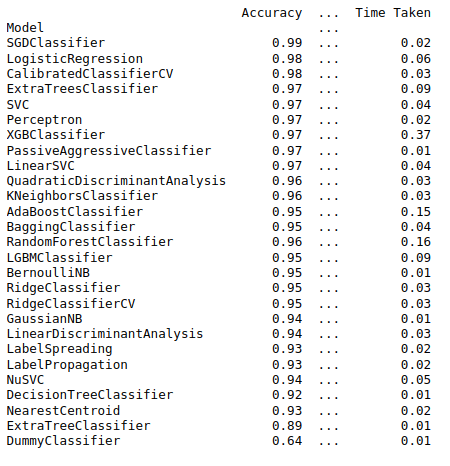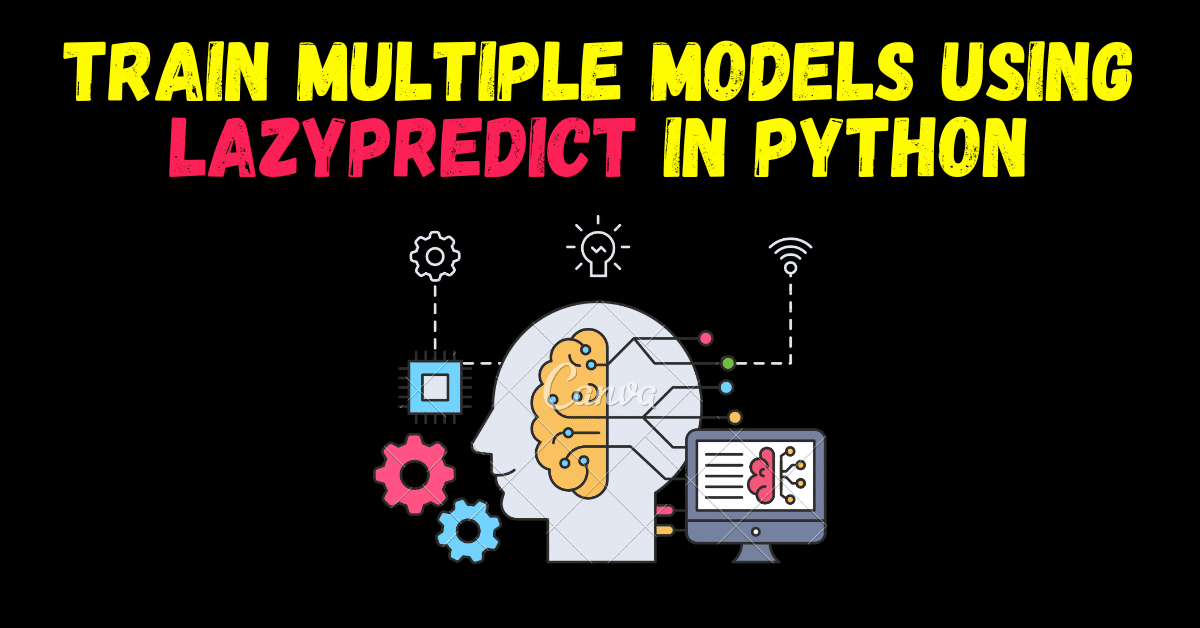Hey guys in this very short blog we will see how we can train and test multiple models using Lazypredict which is an amazing open-source python package. So without any further due, let’s do it…
Lazypredict
LazyPredict is a Python package that helps data scientists quickly build supervised machine-learning models without having to spend time on the tedious and time-consuming task of exploring various algorithms and optimizing hyperparameters. With LazyPredict, data scientists can quickly build and compare several models on their datasets with just a few lines of code. In this article, we will explore LazyPredict and its features.
Installation and Requirements LazyPredict is a Python package that can be installed using pip. The package requires Python 3.6 or higher and scikit-learn 0.22 or higher. Other packages required by LazyPredict are pandas, numpy, scipy, xgboost, lightgbm, catboost, and TensorFlow.
Step 1 – Importing required libraries
!pip install lazypredict from lazypredict.Supervised import LazyClassifier from sklearn.datasets import load_breast_cancer from sklearn.model_selection import train_test_split
- In the very first line, we have installed lazypredict library.
- In the second line, we are importing the LazyClassifier object from lazyprecit.Supervised class.
- And then we are importing breast cancer data from sklearn.datasets and train_test_split from sklearn.model_selection.
Step 2 – Loading sample data
data = load_breast_cancer() X = data.data y = data.target
- We have loaded breast cancer data from sklearn.datasets from which we will further extract features and targets.
- We name features as X and targets as y.
Step 3 – Fitting data on the LazyClassifier object
X_train, X_test, y_train, y_test = train_test_split(X, y, test_size=0.33, random_state=42) clf = LazyClassifier(verbose=0,ignore_warnings=True,custom_metric=None) models,predictions = clf.fit(X_train,X_test,y_train,y_test) print(models)
Results of LazyPredict trained models

Features of Lazypredict
LazyPredict provides several useful features to data scientists. Some of the features are:
- Quick and easy model building With LazyPredict, data scientists can quickly build and compare several models on their datasets with just a few lines of code. LazyPredict supports a wide range of supervised machine-learning algorithms, including linear regression, decision trees, random forests, gradient boosting, neural networks, and more.
- Automatic model selection LazyPredict automatically selects the best model for a given dataset based on the input features and output target. It evaluates and compares several models and returns the best model based on the performance metric specified.
- Hyperparameter optimization LazyPredict automatically optimizes hyperparameters for each model to improve performance. It uses scikit-learn’s GridSearchCV to find the best hyperparameters for each model.
- Support for regression and classification problems LazyPredict supports both regression and classification problems. It automatically detects the type of problem based on the output target.
Conclusion
LazyPredict is a powerful Python package that makes it easy for data scientists to quickly build and compare several machine learning models. With LazyPredict, data scientists can focus on other aspects of their data science workflow and leave the model building and optimization to the package. LazyPredict is an excellent tool for both beginners and experienced data scientists who want to save time building and comparing models.
So this is all for this blog folks. Thanks for reading it and I hope you are taking something with you after reading this and till the next time …
Read my last Blog: 30+ Free and Interesting AI Tools in 2024
Check out my other machine learning projects, deep learning projects, computer vision projects, NLP projects, and Flask projects at machinelearningprojects.net.
